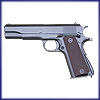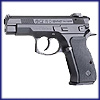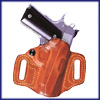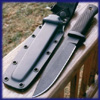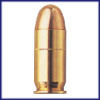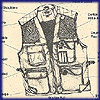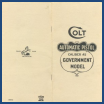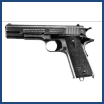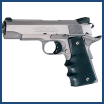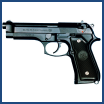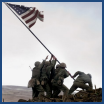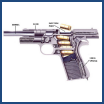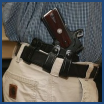This electronic booklet in Adobe Acrobat PDF format contains much of the content of this website plus additional information. You’ll need Adobe Acrobat Reader to view it. Click the link to view the comprehensive M1911A1 Notebook.
Keyword: 1911
Original Colt M1911 & M1911A1 Basic Field Manual (FM 23-35)
We now have the complete Basic Field Manual of the M1911 and M1911A1 online. This is the version which was issued in 1940 and authorized by General George C. Marshall. Special thanks goes to Anthony Gabrielson who did the scanning and OCR which allows this online document to look like the original while having the type in text so that it is searchable and prints using fonts. If you ever wanted to know how to fire your 1911 from horseback at a full gallop, this manual will show you how. It also shows us how the Army expected soldiers to be trained with the M1911 in the WWII era. Included are target and range diagrams, scoring charts, funky old pictures and much more. Enjoy!
- M1911 Manual – Page 1
- M1911 Manual – Page 2
- M1911 Manual – Page 3
- M1911 Manual – Page 4
- M1911 Manual – Page 5
- M1911 Manual – Page 6
- M1911 Manual – Page 7
- M1911 Manual – Page 8
- M1911 Manual – Page 9
- M1911 Manual – Page 10
- M1911 Manual – Page 11
- M1911 Manual – Page 12
- M1911 Manual – Page 13
- M1911 Manual – Page 14
- M1911 Manual – Page 15
- M1911 Manual – Page 16
- M1911 Manual – Page 17
- M1911 Manual – Page 18
- M1911 Manual – Page 19
- M1911 Manual – Page 20
- M1911 Manual – Page 21
- M1911 Manual – Page 22
- M1911 Manual – Page 23
- M1911 Manual – Page 24
- M1911 Manual – Page 25
- M1911 Manual – Page 26
- M1911 Manual – Page 27
- M1911 Manual – Page 28
- M1911 Manual – Page 29
- M1911 Manual – Page 30
- M1911 Manual – Page 31
- M1911 Manual – Page 32
- M1911 Manual – Page 33
- M1911 Manual – Page 34
- M1911 Manual – Page 35
- M1911 Manual – Page 36
- M1911 Manual – Page 37
- M1911 Manual – Page 38
- M1911 Manual – Page 39
- M1911 Manual – Page 40
- M1911 Manual – Page 41
- M1911 Manual – Page 42
- M1911 Manual – Page 43
- M1911 Manual – Page 44
- M1911 Manual – Page 45
- M1911 Manual – Page 46
- M1911 Manual – Page 47
- M1911 Manual – Page 48
- M1911 Manual – Page 49
- M1911 Manual – Page 50
- M1911 Manual – Page 51
- M1911 Manual – Page 52
- M1911 Manual – Page 53
- M1911 Manual – Page 54
- M1911 Manual – Page 55
- M1911 Manual – Page 56
- M1911 Manual – Page 57
- M1911 Manual – Page 58
- M1911 Manual – Page 59
- M1911 Manual – Page 60
- M1911 Manual – Page 61
- M1911 Manual – Page 62
- M1911 Manual – Page 63
- M1911 Manual – Page 64
- M1911 Manual – Page 65
- M1911 Manual – Page 66
- M1911 Manual – Page 67
- M1911 Manual – Page 68
- M1911 Manual – Page 69
- M1911 Manual – Page 70
- M1911 Manual – Page 71
- M1911 Manual – Page 72
- M1911 Manual – Page 73
- M1911 Manual – Page 74
- M1911 Manual – Page 75
- M1911 Manual – Page 76
- M1911 Manual – Page 77
- M1911 Manual – Page 78
- M1911 Manual – Page 79
- M1911 Manual – Page 80
- M1911 Manual – Page 81
- M1911 Manual – Page 82
- M1911 Manual – Page 83
- M1911 Manual – Page 84
- M1911 Manual – Page 85
- M1911 Manual – Page 86
- M1911 Manual – Page 87
- M1911 Manual – Page 88
- M1911 Manual – Page 89
- M1911 Manual – Page 90
The Sight’s M1911 Home Page
The 1911 .45 ACP pistol has a mystique that is unmatched by any other pistol. Its owners are devoted to it. It continues to be chosen by SWAT, special forces, and competitive shooters despite challenges by newer designs and technologies. It is a cultural icon and symbol of America at its combative best. Yes, it’s a combat sidearm, not a pocket gun or a concealment piece. It was designed for the Army in an era when the cavalry rode into battle on horses.
Created by John M. Browning at the turn of the Twentieth Century, the 1911 was the climax of a series of autoloader designs which culminated in the adoption by the Army of the M1911 in the year from which it took its name. It is perhaps the most loved, studied, and enduring pistol design of all time.
This site is a celebration of all things M1911. You’ll find a list of all our schematics, articles, 1911 accessory tips and more laid out in the links on the left and below – enjoy!
1911 Links
The Sight’s Links
- M1911 Links – This list contains every M1911 link I can find on the web
- Other Good Gun Links – This list is a good set of links to shooting related sites that don’t fit neatly into other categories.
- Firearm & 2nd Amendment Discussion Forums – This list is my favorite discussion forums.
- Concealed Carry Links – Because the right to protect yourself shouldn’t stop at your front door.
- Gun Bloggers – My favorites.
- Trail Stories – The M1911 in action
- Reloading Links – Online Resources for Reloaders
- Rifle Links – Mostly AR-15, AK-47, Ruger 10/22 and SKS
- RKBA Links – The Right to Keep and Bear Arms, Second Amendment.
- Military History Links – My collection of military history links.
- The Great Equalizer – Defending yourself and your rights.
- The Best .380 Ammo For Range Training & Self-Defense
- The Best .45 ACP Ammo For Self-Defense & Range Training
- The Best 9mm Ammo For Self-Defense & Range Shooting
- The Best 10mm Ammo For Self-Defense & Range Training
Caring For The 1911
Check out the links below for the best information on taking care of your M1911 handgun. The Colt 1911 and 1911A1 pistols are some of the best pistols ever made, but like any other fine machine, they do need general maintenance and upkeep. The following pages will make sure your Colt runs reliably.
More 1911 Legends
- Major Charles W. Davis
- Corporal Dan D. Schoonover
- Specialist Dwight H. Johnson
- Sergeant Darrell Samuel Cole
- General Joe Foss
- Master Sergeant Gary I. Gordon
- Captain Harold A. Fritz
- Corporal Henry F. Warner
- First Lieutenant Harry Linn Martin
- Private, First Class Jack G. Hanson
- Second Lieutenant John J. McGinty III
- Second Lieutenant Patrick Regan
- Technician Robert D. Maxwell
- Sergeant First Class Randall D. Shughart
- Hospital Apprentice First Class Robert Eugene Bush
- Lieutenant Colonel Robert G. Cole
- Petty Officer R. J. Thomas
- John E. Holbrook
- Sergeant Thomas A. Baker
- First Lieutenant William B. Turner
- First Lieutenant Willibald C. Bianchi
- Lieutenant Colonel William J. O’Brien
M1911 vs. M9
M1911 vs. M9
In 1985, the United States Armed Forces replaced the M1911 with the Beretta 92 F to the everlasting consternation of 1911 devotees everywhere. There were several reasons for the switch. The U.S. was the only NATO country not using a 9mm as the standard issue sidearm and there was a desire to issue a pistol chambered for the ubiquitous 9mm for logistical reasons. The Beretta will hold 15 rounds in its magazine as compared with 7 rounds of the military issue 1911 magazine and is lighter and easier to field strip than the 1911. The double action/single action Beretta was perceived as being a safer pistol to carry in a state of readiness than the “cocked and locked” 1911. In some quarters, the .45 ACP was viewed as too powerful and difficult to control for those having only nominal training with the weapon.
Defenders of the 1911 will vehemently contest these last three perceptions, pointing to the superior trigger and durability of the 1911, and the superior stopping power and inherent accuracy of the .45 ACP cartridge. In terms of safety, three conditions must be met for the cocked and locked 1911 to fire: (1) a firing grip must depress the grip safety; (2) the manual safety must be taken off, and (3) the trigger must be pulled. Nevertheless, it looks scary and the Armed Forces have documented negligent discharges from improperly handled pistols.
It could be said that the 1911 fell victim to its own mythology. I grew up hearing the stories of the .45–that it kicked so badly that an inexperienced person couldn’t hit a door from twenty feet away with one, that a man, struck anywhere on the body by a .45 round would be knocked down as if hit by a truck, and that you could shoot down a Japanese Zero with a .45. (A Zero was downed with a .45 but by a head shot on the pilot by an American aviator parachuting from a bomber. The Zero was trying to strafe the American.) In 1998 The FBI S.W.A.T. team adopted the Springfield 1911A1 as standard issue. Anecdotal evidence out of Desert Storm indicates that the Berettas jammed because of the fine sand in the desert and the Marines broke out the 1911’s.
My Own Opinion:
The M9, Beretta 92 F, has the smoothest slide and the lightest recoil spring of any major caliber pistol I know of. When you rack the slide of the M9, you can feel the precision and quality of its manufacture. Those bottomless 15-round magazines could prove to be life savers should you decide to shoot it out with the Crips or invade a small foreign country. My wife is of the opinion that the Beretta is the nicest shooting autoloader around. It has a very good trigger for a DA/SA and the long barrel and sight radius give it adequate accuracy.
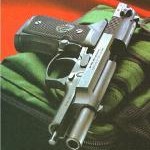 Too bad the 92 F is a 9mm. The 9mm is a reasonable defensive round. It will do its part if you do yours, but of course, the same could be said of a .32 caliber pocket gun. Questions have been raised about the “stopping power” of the 9mm and people whose lives depend on their handguns have been migrating away from the 9mm and toward the .40 S&W and .45 ACP in recent years. If I had to shoot someone and I had one shot to do the job, I’d rather that shot be a 230 grain .45 ACP.
Too bad the 92 F is a 9mm. The 9mm is a reasonable defensive round. It will do its part if you do yours, but of course, the same could be said of a .32 caliber pocket gun. Questions have been raised about the “stopping power” of the 9mm and people whose lives depend on their handguns have been migrating away from the 9mm and toward the .40 S&W and .45 ACP in recent years. If I had to shoot someone and I had one shot to do the job, I’d rather that shot be a 230 grain .45 ACP.
My target and competition gun is a Colt Combat Commander. The question of “inherent accuracy” is the grist of endless debates, but I do believe that some cartridges are more inherently accurate than others. I base this on nothing more than my own experience with shooting them. In my hands, .38 and .45 are more accurate rounds than 9mm and .40 S&W. I shoot .45 with much greater accuracy than I do 9mm, so it is more rewarding for me to shoot .45 for fun and competition. .45 ACP is heavier and more expensive than 9mm, and folks who are particularly recoil sensitive will enjoy the 9mm more than the .45. Last, but not least, 9mm pistols tend to be lighter and more comfortable to carry than 1911s, although some lightweight models of the 1911 are beginning to appear.
Did the Armed Forces make a good choice? Well, I hope so. The M1911 isn’t the best gun for a beginner. In an absolute sense, the M9 is probably safer at ready than an M1911, although, in the hands of a trained person, the 1911 is perfectly safe. The additional rounds might also be an advantage to the nominally trained soldier or law enforcement officer possessed of marginal marksmanship. Which one do I like the best? The M1911, of course.
See also:
The True Story of the Beretta M9 Pistol. by Tim Chandler
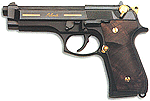
MORE BERETTA 92 LINKS
Francesco’s Unofficial Beretta Page
M9 Manual (PDF) from BiggerHammer
1911 .45 ACP Production Information
Military Versions from 1912 to 1945.
Manufacturer/Serial Number/Date Made
Beginning of M1911:
1) Colt: S/N 1 to 3190 = April 16, 1912 to May 31, 1912
2) Colt: S/N 3190 to 7501 = May 31, 1912 to Oct. 10, 1912
- (S/N 3501 to 3799 were first U.S.M.C. pistols made by Colt delivered June 6, 1912.)
3) Colt: S/N 7501 to (approximately) 20,000 = Oct. 10, 1912 to Jan. 1913
4) Colt: S/N (approx.) 20,000 to 83,856 = Jan. 1913 to Aug. 19, 1913
- S/N 38,001 to 43,900 Navy Model (USS New York) = March 9, 1912 to March 5, 1915
- S/N 43,901 to 44,000 Navy Model (USS Texas) = March 9, 1912 to March 5, 1915
- S/N 36,401 to 37,650 U.S.M.C. Model made by Colt = July 9, 1913
5) Colt: S/N 83,856 to 89,801 = Aug. 19, 1913 to July 20, 1914
- (S/N 83,901 to 84,400 U.S.M.C. Model = May 12, 1914)
6) Colt: S/N 89,801 to 108,601 = July 20, 1914 to Feb. 8, 1915
- (S/N 96,001 to 97,537 Navy Model (U.S. Navy Yard, Brooklyn, N.Y.) = March 9, 1912 to March 5, 1915)
7) Colt: S/N 108,601 to 290,000 = Feb. 8, 1915 to May, 1918
- (S/N 109,501 to 110,000 Navy Model, S/N 223,953 to 223,991 Navy Model, S/N 232,001 to 233,600 Navy Model)
- (S/N 151,187 to 151,986 U.S.M.C. Model, S/N 185,801 to 186,201 U.S.M.C. Model, S/N 209,587 to 210,386 U.S.M.C. Model, S/N 215,387 to 217,386 U.S.M.C. Model)
8) Colt/Springfield: S/N 128,617 to 133,186 = 1916 to 1924 ( These models are very hard to properly identify)
9) Colt: S/N 290,000 to 450,000 = May, 1918 to Oct. 24, 1918
10) Colt: S/N 450,000 to 629,500 = Oct. 24, 1918 to April 10, 1919
11) Springfield Armory: S/N 72,571 to 133,186 = April 1914 to April, 1917
12) Remington-UMC: S/N 1 to 15,000 = Aug. 10, 1918 to May 24, 1919
13) Remington-UMC: S/N 15,000 to 21,676 = Aug. 10, 1918 to May 24, 1919
14) North American Arms: S/N 1 to 100 & S/N’s 111, 222, 333, 444, 555 = July 1, 1918 to Dec. 4, 1918. They are very rare and rank in value with Singer models. ( None of these were reported shipped to any branch of the military but about 100 regular models and about 5 presentation models were manufactured in Quebec, Canada by the North American Arms Company, Ltd.)
15) A. J. Savage Munitions Co. was issued a contract on July 20, 1918 and canceled on Dec. 4, 1918. Some parts were made but no complete pistols. It is unknown for sure if any slides were made and no frames were made.
Beginning of M1911A1:
14) Colt ( Transition Models): S/N 700,000 to 710,000 = 1924
15) Colt: S/N 710,001 to 711,000 = Early 1937
16) Colt: S/N 711,001 to 712,350 = Mid to Late 1937
17) Colt: S/N 712,350 to 713,645 = 1938
18)Colt: S/N 713,646 to 717,281 = 1939
- Begining in 1940, the slide’s muzzel end was hardened after the finish was applied but a color mis-match was suppose to be rejected.
- From 1942 to 1945 all 1911A1 pistols should show a slight to very noticed mismatch of coloring on the muzzle end of slide, and from 1943 the slide lock notch area should also show some discoloration from hardening after the pistol’s finish was applied.
19) Colt: S/N 717,282 to 721,977 = 1940
20) Colt: S/N 721,977 to 756,733 = 1941
21) Colt: S/N 756,734 to 857,000 = 1942 (S/N’s 856,405 to 916,404 were also duplicated by Ithaca but will have “F.J.A.” Ithaca inspection initials.)
22) Colt: S/N 857,000 to 1,609,529 = 1943 (S/N’s 856,405 to 916,404 were duplicated by Ithaca look for “F.J.A.” Ithaca inspection initials. S/N’s 1,041,405 to 1,096,404 were duplicated by Union Switch & Signal. Look for “RCD” US&S inspection initials.)
23) Colt: (Commercial/Military Model) S/N 857,000 to 1,609,529 = 1943 (approx. 6,575 Commercial models were converted to military production. Colt stop it’s commercial production at S/N C215,083)
24) Colt: S/N 1,609,529 to 1,743,846 = 1944
25) Colt: S/N 2,244,804 to 2,380,013 = 1945
26) Remington Rand: S/N 916,405 to 955,000 = 1943
27) Remington Rand: S/N 955,001 to 980,000 = 1943
28) Remington Rand: S/N 980,001 to 995,000 = 1943
29) Remington Rand: S/N 995,000 to 1,041,404 = 1943
30) Remington Rand: S/N 1,279,699 to 1,441,430 = 1943
31) Remington Rand: S/N 1,471,431 to 1,609,528 = 1943
32) Remington Rand: S/N 1,743,847 to 1,816,641 = 1944
33) Remington Rand: S/N 1,890,504 to 2,075,103 = 1944
34) Remington Rand: S/N 2,134,404 to 2,244,803 = 1945
35) Remington Rand: S/N 2,380,014 to 2,619,013 = 1945
36) Ithaca: S/N 856,405 to 900,000 = 1943 ( S/N’s 856,101 to 958,100 were duplicated by Colt, look for “G.H.D.” or “W.B.” Colt inspection initials.)
37) Ithaca: S/N 900,001 to 914,000 = 1943
38) Ithaca: S/N 914,000 to 916,404 = 1943
39) Ithaca: S/N 1,208,674 to 1,279,673 = 1943
40) Ithaca: S/N 1,441,431 to 1,471,430 = 1943
41) Ithaca: S/N 1,816,642 to 1,890,503 = 1944
42) Ithaca: S/N 2,075,104 to 2,134,403 = 1945
43) Ithaca: S/N 2,619,014 to 2,693,613 = 1945
44) Singer: S/N S800001 to S800500 = 1941 ( Use great care in evaluating these. They are very rare and valuable. This pistol is also counterfeited the most.) Slide markings are: S. MFG. CO. ELIZABETH,N.J., U.S.A.
45) Union Switch & Signal: S/N 1,041,405 to 1,060,000 = 1943
46) Union Switch & Signal: S/N 1,060,000 to 1,096,404 = 1943 (S/N’s 1,088,726 to 1,092,896 were duplicated by Colt. Look for “G.H.D.” or “W.B.” Colt inspection initials.)
Special Versions:
1) Springfield Armory: U.S. ARMY NATIONAL MATCH = 1954 to 1967 (Very hard to identify. Early 1954 models looked like regular 1911A1 and later versions usually had adjustable sights.)
2) U.S. AIR FORCE MATCH = 1958 to 1970 ( Produced by U.S.A.F. Gunsmiths. Very hard to identify except should have AFPG stamped on frame. A M1911A1 similar to Army National Match.)
3) Colt “ACE”: Caliber = .22 Long Rifle S/N 1 to 10,935 = April 1931 to July 1941 (The last 190 or so were assembled from spare parts in 1947) Parts only partially interchangable with a .45 caliber M1911A1 pistol.
4) Colt Service Model “ACE” : Caliber .22 Long Rifle S/N SM 1 to SM 3,836 = Feb. 1936 to Jan. 1943 ( Between 1935 and Sept. 1945, 11,961 Colt Service Model “ACE” pistols were made and their parts were fully interchangable with the .45 caliber
M1911A1.
5) Colt Service Model “ACE” : S/N SM 3846 to SM 13,803 = April 1945 to Sept. 1945 ( Between 1938 and Oct. 1946, a total of 2149 .22-.45 conversion units were made to convert .45 caliber pistols to .22 caliber. They were: S/N U1 to U2670. From 1938 to 1940, .45-.22 conversion units were made to convert Service Model “ACE” .22 caliber pistols to .45 ACP. They were: S/N U1 to U112.)
Foreign Service Models:
1) Colt M1911 Canadian Contract: S/N C5400 to C16599 = Sept. to Nov., 1914 ( Only 5000 pistols in this serial number range were shipped to Canada.) Caliber .45 ACP
2) Colt M1911A1 Canadian Contract: S/N 930,000 to 936,000 = 1943 ( 1,515 military model pistols were shipped to Canada through the Lend-Leased Act from this serial number range.) Caliber .45 ACP
3) Colt M1911 British Contract: S/N W29117 to W97000 and S/N C29 to C74,200 = May 1912 to April 1919 (Approx. 17,500 pistols were shipped to England. Serial numbers that begin with a “C” were .45 ACP and serial numbers that begin with a “W” were .455 Webley calibers.
4) Colt M1911 British RAF Contract: S/N W91,100 to W110,696 = Jan. 22, 1918 to April 28, 1919 (Approx. 10,000 pistols were shipped to the Royal Air Force from this serial number range and were .455 Webley caliber.)
5) British M1911A1 WW II Lend-Lease: From all S/N’s of U.S. M1911A1 models = March 11, 1941 through the rest of WW II ( The U.S. furnished 39,592 pistols to Britain through the Lend-Lease Act.)
6) Colt M1911 Russian Contract: S/N C23000 to C89000 = Feb. 19, 1916 to Jan. 18, 1917 ( Russia purchased 51,000 M1911 .45 ACP pistols during WW I. from this serial number range. Russia purchased more M1911 pistols than any other country besides the U.S.) Regular commercial model Colt except has “English Order” mark in Russian on left side of frame.
7) Colt M1911 Norwegian: Colt S/N C18501 to C18850 and Norway S/N 1 to 5000 = June 1915 to WW II (400 Colt 1911’s .45 caliber purchased and issued to Norwegian Navy. May 1917, 300 Colt 1911 .45ACP pistols purchased in 1915. In 1917, Norway obtained licence to manufacture it’s M1911 pistols. The first they made had “COLT AUT PISTOL M/1912” on the slides and then at S/N 100 this changed to “11.25 m/m AUT. PISTOL M/1914” on the slides.
8) Colt M1911 Argentine: S/N C6201 to C11621 = 1914, S/N C20,001 to C21000 = 1916 S/N C86790 to C116000 = 1919 ( 321 shipped in 1914 marked on right side of slide with “MARINA ARGENTINA”. In 1915 another 1000 shipped within above S/N range. In 1919 another 400 M1911 Colts shipped in above S/N range. Imported into the U.S. in 1960 as surplus but very rare in any condition.)
9) Colt M1911A1 Argentine Modelo 1927: S/N 1 to 10,000 = July 28, 1927 to Feb. 16, 1928 ( Marked on slide with ” COLT CAL. 45 MOD. 1927″ and S/N’s stamped on top of slide in Colt’s italic numbers.) SYST. COLT pistols made by Argintina under licence from Colt marked on right of slide with “EJERCITO ARGENTINO / SIST. COLT CAL 11.25 mm. Model 1927”. Other M1911A1 pistols made in Argintina at Fabrica Militar de Armas Portatiles, Rosario, Argintina S/N 10,001 to 112,000
10) Colt M1911 MEXICAN: After WW I, Mexico procured an unknown number of M1911 pistols made by Colt. These are rare because of Mexico’s strict penalties for illegal possession of military arms (ON SPOT EXECUTION). Very few made it to U.S. and would have a “C” prefix serial numbers. May have “EJERCITO MEXICANO” on right side of slide.
Colt Commercial Production: Govt. Model: 1912 to 1981
Model 1911
Serial Numbers – Date – Number Made
S/N C1 to C1899 – 1912 – 1899
S/N C1900 to C5399 – 1913 – 3500
S/N C5400 to C16599 – 1914 – 11,200
S/N C16600 to C27599 – 1915 – 11,000
S/N C27600 to C74999 – 1916 – 47,400
S/N C75000 to C98999 – 1917 – 24,000
S/N C99000 to C105999 – 1918 – 7000
S/N C106000 to C120999 – 1919 – 15,000
S/N C121000 to C126999 – 1920 – 6000
S/N C127000 to C128999 – 1921 – 2000
S/N C129000 to C129999 – 1922 – 1000
S/N C130000 to C133999 – 1923 – 4000
Some special military orders and military contractor orders were made.
- The following pistols were shipped to Major Cyrus S. Radford, U.S. Marine Corps Reserve, on Feb. 13, 1917. with a prefix of 1 to 25 added to serial numbers.
- S/N’s 1-C92505, 2-C92332, 3-C92227, 4-C91632, 5-C91739, 6-C91936, 7-C92359, 8-C91710, 9-C92326, 10-C92290, 11-C92239, 12-C92335, 13-C92291, 14-C92250, 15-C92347, 16-C92244, 17-C92343, 18-C92249, 19-C92156, 20-C92337, 21-C92358, 22-C92245, 24-C92243, 25-C92294
- S/N C201069 shipped to Springfield Armory on Sept. 28, 1919 for prototype tests.
__________________________________________________________________
Model 1911A1
Serial Numbers – Date – Number Made
S/N C135000 to C139999 – 1924 – 5000
S/N C140000 to 144999 – 1925 – 5000
S/N C145000 to C150999 – 1926 – 6000
S/N C151000 to C151999 – 1927 – 1000
S/N C152000 to C154999 – 1928 – 3000
S/N C155000 to C155999 – 1929 – 1000
S/N C156000 to C158999 – 1930 – 3000
S/N C159000 to C160999 – 1931 – 2000
S/N C161000 to C164799 – 1932 – 3800
S/N C164800 to C174599 – 1933 – 9800
S/N C174600 to C177999 – 1934 – 3400
S/N C178000 to C179799 – 1935 – 1800
S/N C179800 to C183199 – 1936 – 3400
S/N C183200 to C188699 – 1937 – 5500
S/N C188700 to C189599 – 1938 – 900
S/N C189600 to C198899 – 1939 – 9300
S/N C198900 to C199299 – 1940 – 400
S/N C199300 to C208799 – 1941 – 9500
S/N C208800 to C215018 – 1942 – 6219
- Production Stopped because of World War II. Commercial models converted to military use except for limited production of Service Model “ACE” with S/N’s around SM2715.
- .22 to .45 Conversion Units made from S/N U1400 to 1700.
- In 1943, commercial models used to fill military orders. A limited amount of Super 38 & Super Match 38 produced. .22 to .45 Conversion Units made S/N U1701 to S/N U1750.
- In 1944 no commercial peroduction of any kind recorded.
- S/N SM3725 to SM13803 Service Model “ACE” .22 made, some gaps in numbering
- produced in 1945. Commercial production resumed in 1946.
S/N C221001 to C222000 – 1946 – 1000
S/N C222001 to C231999 – 1947 – 9999
S/N C232000 to C238500 – 1948 – 6501
S/N C238501 to C240000 – 1949 – 1500
S/N C240001 to 247700C – 1950 – 7700
S/N 247701C to 253179C – 1951 – 5479
S/N 253180C to 259549C – 1952 – 6370
S/N 259550C to 266349C – 1953 – 6800
S/N 266350C to 270549C – 1954 – 4200
S/N 270550C to 272549C – 1955 – 2000
S/N 272550C to 276699C – 1956 – 4150
S/N 276700C to 281999C – 1957 – 5300
S/N 282000C to 283799C – 1958 – 1800
S/N 283800C to 285799C – 1959 – 2000
S/N 285800C to 287999C – 1960 – 2200
S/N 288000C to 289849C – 1961 – 1850
S/N 289850C to 291299C – 1962 – 1450
S/N 291300C to 293799C – 1963 – 2500
S/N 293800C to 295999C – 1964 – 2200
S/N 296000C to 300299C – 1965 – 4300
S/N 300300C to 308499C – 1966 – 8200
S/N 308500C to 315599C – 1967 – 7100
S/N 315600C to 324499C – 1968 – 8900
S/N 324500C to 332649C – 1969 – 8150
S/N 332650C to 336169C – 1970 -3520
During 1970 the change to the new series “70” begins and serial numbers changed also.
S/N 70G01001 to 70G05550 – 1970 – 4550
S/N 70G05551 to 70G18000 – 1971 – 12,450
S/N 70G18001 to 70G34400 – 1972 – 16,400
S/N 70G34401 to 70G43000 – 1973 – 8600
S/N 70G43001 to 70G73000 – 1974 – 30,000
S/N 70G73001 to 70G88900 – 1975 – 15,900
S/N 70G88901 to 70G99999 – 1976 – 11,099
During 1976 a range change of serial number begins.
S/N 01001G70 to 13900G70 – 1976 – 12,900
S/N 13901G70 to 45199G70 – 1977 – 31,299
S/N 45200G70 to 89185G70 – 1978 – 43,986
S/N 89186G70 to 99999G70 – 1979 – 10,813
During 1979 a range change of serial numbers begins on March 20, 1979.
S/N 01000B70 to 30008B70 – 1979 – 29,008
S/N 30009B70 to 72989B70 – 1980 – 42,981
S/N 72990B70 to 99999B70 – 1981 – 27,009
During 1981 a range change of serial numbers begins on Oct. 17, 1981.
S/N 70B00001 to 70B11246 – 1981 – 11,246
Some special orders made for military or military contractors. These are as follows:
- S/N C211458 Sept. 22, 1942 shipped to Scovill Manufacturing Co. Waterbury, Conn.
- S/N’s C212147, C212332, C212486, C212495 Sept. 29, 1942 shipped to Winchester
- Repeating Arms Co.
- S/N’s C213341, C213242, C213343, C213345 May 27, 1942 shipped to Remington
- Arms Co. Bridgeport, Conn.
- S/N C214360 Jan. 2, 1945 Shipped to U.S. Naval Academy, Annapolis, Md.
- S/N’s C214752, C214753, C214754 April 3, 1942 Shipped to Winchester Repeating
- Arms Co.
- S/N C214833 Nov. 10, 1942 Shipped to Capt. A. H. Harris, Hartford Ord. District.
- S/N C213905 Oct. 8, 1942 Shipped to J. A. Lorch, Washington, D.C.
- S/N C214016 Oct. 9, 1942 Shipped to Dominion of Canada.
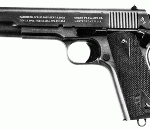
1911 Reading Library
Much of the best material on the Sight can be found here. The Library contains articles on CCW, RKBA, 1911 Technical and Historical issues, Gun and Equipment reviews and other stuff that I can’t think of another place for.
1911 History
History of the M1911 Pistol
We identify genius by its impact. It changes things and its vision endures. In the world of firearms, there is one designer whose work changed everything and endures, John Moses Browning. Browning is most frequently remembered as the designer of the 1911 .45 ACP and the Browning High Power, but he also created the Winchester 30-30, The Winchester Pump Shotgun, The Browning Auto-5 Shotgun (produced by Remington as the Model 11), The BAR (Browning Automatic Rifle) and the Browning .50 caliber Machine Gun, plus most of the .30 cal and .50 cal machine guns produced by Colt and used in WW II. He is credited with 128 gun patents, and some fifty million sports and military weapons were manufactured from those patents during the forty-seven years he was an active inventor.
During the same time frame that John Browning was putting the Winchester Repeating Arms Company on the map, a highly motivated tribe of warriors, known as the Moro, were giving the U.S. Army fits in the Philippines. To prepare for battle, the Moro used a combination of body binding with leather, narcotics, and religious ritual to put themselves into an altered state of consciousness which left them insensible to injury. Soldiers found that their revolvers chambered in .38 Long Colt simply would not stop the Moro. It should be noted that their .30 Krag rifles didn’t do a whole lot better against these warriors.
John Browning began to experiment with self-loaders in 1889, inspired by Hiram S. Maxim who had invented a machine gun six years earlier. Browning converted a Winchester 1873 lever-action to an autoloader by using the action of the gases at the muzzle. A machine gun using this same operating principle was built in 1890 and 1891. From this work evolved a machine gun design ultimately built and sold by Colt as the Model 1895 machine gun, popularly called the “Browning Potato Digger” because of its downward arcing, gas-operating piston system. Browning’s first self-loading pistol was also a gas-operated weapon.
Based on the experience with the Moros and extensive testing on animals and human cadavers, an Army Ordnance Board headed by Col. John T. Thompson (inventor of the Thompson sub-machine-gun) and Col. Louis A. La Garde, determined that the Army needed a .45 caliber cartridge to provide adequate stopping power. In the mean time, Browning who was working for Colt, had already designed an autoloader pistol, around a cartridge similar in dimension to the .38 Super. When the Army requested designs for a new handgun, Browning re-engineered this .38 autoloader to accommodate a .45″ diameter cartridge of his own design with a 230 gr. FMJ bullet, and submitted the pistol to the Army for evaluation.
The selection trials began in 1906 and Browning’s pistol faced competition from pistols submitted by Colt, Luger, Savage, Knoble, Bergmann, White-Merrill and Smith & Wesson. Browning’s design and the Savage design were selected in 1907. The Army called for additional tests of function and reliability which revealed that neither Colt’s nor Savage’s offerings had reached the desired perfection. The Ordnance Department instituted a series of further tests and experiments, which eventually resulted in the appointment of a selection committee in 1911.
Browning was determined to prove the superiority of its handgun, so he went to Hartford to personally supervise the production of the gun. There he met Fred Moore, a young Colt employee with whom he worked in close cooperation trying to make sure that each part that was produced for the test guns was simply the best possible. The guns produced were submitted again for evaluation to the committee. A torture test was conducted on March 3rd, 1911. The test consisted of having each gun fire 6000 rounds. One hundred shots would be fired and the pistol would be allowed to cool for 5 minutes. After every 1000 rounds, the pistol would be cleaned and oiled. After firing those 6000 rounds, the pistol would be tested with deformed cartridges, some seated too deeply, some not seated enough, etc. The gun would then be rusted in acid or submerged in sand and mud and some more tests would then be conducted.
During the trials, several alterations were made to the original design such as a single swinging link, an improved manual safety, and the inclusion of a grip safety and a slide stop. The other significant change was to the grips, which were angled more acutely and lengthened slightly.
In its final form, the M1911 was a locked-breech, single-action semi-automatic pistol. It was chambered for the .45 ACP cartridge and had a magazine capacity of seven rounds. Its weight unloaded was 39 ounces; overall length was 8.25″; the height was 5.25″. Sights were fixed, although the rear sight was housed in a dovetail slot that allowed it to be drifted either left or right for windage adjustments. The pistols were finished in blue and fitted with checked wood stocks.
Browning’s pistols passed the whole test series with flying colors. It was the first firearm to undergo such a test, firing continuously 6000 cartridges, a record broken only in 1917 when Browning’s recoil-operated machine gun fired a 40000 rounds test.
The report of the evaluation committee (taken from “The .45 Automatic, An American Rifleman Reprint,” published by the National Rifle Association of America) released on the 20th of March 1911 stated :
“Of the two pistols, the board was of the opinion
that the Colt is superior, because it is more
reliable, more enduring, more easily disassembled
when there are broken parts to be replaced, and
more accurate.”
On March 29th, 1911, the Browning-designed, Colt-produced .45 Automatic pistol, was selected as the official sidearm of the Armed Forces of U.S.A., and named Model 1911.
When we entered the Great War, the U.S. government had purchased some 140,000 M1911 pistols from both Colt and Springfield Armory. The Armory tooled up in 1913 to make M1911s and help fill initial orders. Altogether some 31,000 M1911s were built at Springfield prior to the U.S. entry into World War I. To meet wartime requirements, they made 45,000 more, all in 1918.
Guns made for these production runs were all stamped UNITED STATES PROPERTY on the frame. The slide carried the inscription MODEL OF 1911 U.S. ARMY. Production runs increased when the World War I started and continued to increase through 1918. By May 1918, it had increased to 1,000 per day. The summer months of 1918 saw an increase to 2,200 per day.
To meet the needs of our expanding armed forces, 1917 planners estimated that a total of 765,000 pistols would be required. The estimate was later revised upward, first to 1.3 million and then to 2.7 million.
Filling the projected needs meant that pistols would have to be made by contractors other than Colt. Thus orders were placed with Remington-UMC, Winchester, Burroughs Adding Machine Co., Lanston Monotype Machine Co., National Cash Register Co., A.J. Savage Munitions Co., Savage Arms Co., and two Canadian firms, Caron Brothers Mfg. Co., and North American Arms Co., Ltd. Of those firms, only Remington-UMC delivered any meaningful quantity (22,000 of 150,000 ordered). North American did make some pistols, but the total was probably less than 100.
A number of foreign companies or governments were licensed to manufacture the Colt-Brownings in a variety of calibers. It is interesting to note that Colts at one time were produced under the direction of the Nazi government. In 1915 the Norwegian government was licensed to manufacture the pistols. When Nazi troops occupied Norway in World War II, they ordered the government arsenal to start production. The Nazi’s planned to use the pistol to arm their occupying forces. However, only about 1,000 guns were produced in 1941 and 1942.
After World War I, the Army’s Ordnance Department evaluated the Colt .45’s combat performance. They recommended the following changes:
1. Wider front sight to develop “Patridge-type” of sights, allowing the shooter to quickly align both front and rear sights under various lighting conditions.
2. Longer hammer spur. Both changes 2 and 3 work together to prevent the web between the thumb and the forefinger being pinched between the hammer and the safety spur when the gun is fired.
3. Longer grip-safety spur.
4. Arched spring housing fills the shooter’s hand and checkering backstrap provides a better grip.
5. Relief cuts in the frame around the trigger allowing easier access to the trigger.
6. Shorter trigger with knurled face to avoid the trigger finger from slipping.
These changes were put into production on June 15, 1926 as AUTOMATIC PISTOL, CALIBER .45, MODEL OF 1911A1.
World War II was a replay of the situation in 1917, but worse. Colt .45s were in demand, not only by the U.S. Armed Forces, but also by the military establishments of our major allies. Again, contractors other than Colt provided the balance of the 2.5 million .45s made during 1941 to 1945. In all, four contractors added their share to Colt’s 480,000-pistol contribution. Remington-Rand produced 1.03 million. Ithaca turned out 370,000. Union Switch and signal Co. of Swissvale, Pa., received and filled an order for 55,000 M1911A1s. And Singer Sewing Machine contracted to provide 500 1911A1 pistols—which it did.
In the early 1970s, the Army decided to do something for its General Officers in terms of personal protection. The M1908 Colt Pocket Hammerless pistols issued to General Officers since World War II had finally outlived their service life. To correct this situation, Rock Island Arsenal, Rock Island, Illinois began modifying the standard M1911-A1. The pistol’s slide and barrel were shortened just over .75″(1.905cm) and the barrel had one locking lug removed. A full-length recoil spring guide was installed, as was an enlarged set of fixed sights. Checkered, walnut grip panels inlaid with a plate bearing the officer’s name replaced the standard pistol’s brown plastic grips. Adopted in 1972 as the United States Pistol, General Officers’, Caliber .45, M15, it is similar in both size and weight to the civilian Colt Combat Commander. The M15’s increased muzzle blast and recoil are a small price to pay for what is hoped to be a personal weapon of last resort
The M1911-A1 pistol remained in service through World War II, the Korean War, and the War in Vietnam. The old war-horse proved to be particularly useful in the tunnel fighting that went on in Vietnam. For more info on the discernment of the various manufacturers of 1911 pistols during the war years, see the Who Made It?
The Norwegian 1911 (Model 1912 and 1914)
Colt .45 Autos have been copied, both here and abroad, almost since the first ones were made. The first of the foreign copiers was Norway. Seeking a suitable semi-automatic pistol, the Norwegian military decided on the M1911 as early as 1912. In 1913 and 1914, the Norwegians purchased 300 commercial .45s from Colt and then, having established that no Norwegian product was acceptable, began to negotiate for a license to build guns in Norway. Under an agreement signed in January, 1915, payment of 25,000 kroner bought the Norwegians a set of Colt’s drawings and the right to make M1911 pistols at their Kongsberg Weapons Factory for as long, and in whatever quantity they desired.
Formally adopted as the “Colt Automatisk Pistol Model 1912,” the first 500 guns are virtual twins of the Colt product, differing only in marking. The second production lot, begun in 1919, carried a different slide marking — 11.25 m/m Aut. Pistol M/1914. The M/1914 also features a slide release lever that is distinctly different from those on both Colt and M/1912 Norwegian pistols.
The Kongsberg plant turned out about 20,000 M/1914 pistols between 1919 and the early ‘30s. Then, military demand satisfied, the line shut down. Under German occupation during World War II, the production of M/1914 was re-started, and another 10,000 were produced. Following the war, a few M/1914s were assembled from parts to bring the total made to just under 33,000.
— From The .45 Automatic, “Service Pistol Surrogates” by J.B. Roberts, Jr.
M1911-A1 Modelo 1927
After adoption of the M1911A1 in the United States, the Argentine government purchased the pistol from Colt as the Model 1927. The order to Colt was for a run of 10,000 guns for the Argentine Army. These guns were serial numbered in their own range from 1 to 10000. The original finish of these guns was blued with a brush blue finish and they had checkered walnut grips. The way to recognize them is that on the right side of the slide it has the following markings:
EJERCITO ARGENTINO
Colt CAL. 45 MOD. 1927 S/N
In the 1930’s, the Argentines secured license to manufacture their own .45s. These are called “Sistema Colt” to distinguish them from the actual Colt Modelo 1927. These Model 1927s were made by Fabrica Militar de Armas Portatiles “Domingo Matheu,” in Rosario, Argentina. They are marked “F.M.A.P” or “D.G.F.M. (F.M.A.P)” on the left side of the slide and “Ejercito Argentino, Sist. Colt, cal. 11.25 m.m. MOD 1927” in two lines on the right. All Model 1927s bear the Argentine seal on the slide.
An estimated 38,000 copies of the Colt M1911 .45 caliber pistol were made at Rosario; another 75,000 were produced in 1947-1966 (some of which were still in service with elements of the Argentine military during the Falklands/Malvinas war in 1982).
All Sistemas were originally blued, except a few that were specially ordered for the Navy. Early guns had checkered walnut stocks, later had black or brown hard rubber. They were numbered on the frame, slide, barrel, and magazine. Most examples noted have been either reblued, or phosphated; many of the phosphated examples have blued small parts.
In addition to military production, the firm of Hispano Argentino Fabrica de Automoviles. SA (HAFDASA), manufactured an unlicensed copy of the Colt known as the “Ballester-Molina.” Most features of the HAFDASA gun are taken directly from the Colt product. The trigger and trigger linkage differ, however, in that the trigger pivots, and the trigger extension is external. The Ballester-Molinas also lack the grip safety. The story that the Ballester-Molinas are made from steel from the German battleship Graf Spee is a delightful but false legend. Both the Model 1927 and the HAFDASA .45s are extremely well-made pistols. For more on the Ballester-Molina, click here.
Civilian Commercial Production by Colt
In the early 1930’s, Colt offered a target version of the basic civilian Model 1911. This National Match pistol first appeared in 1933. These pistols differed from the standard grade because they incorporated a match barrel, checked trigger, checked arched grip, walnut stocks and the internal parts were hand honed. Also included on later versions were a ramped front sight and an adjustable rear sight. These models were marked “NATIONAL MATCH COLT Automatic Calibre .45” on the left side of the slide. During World War II, the National Match Model was discontinued, but resumed in 1957. This newer version was referred to as the “Gold Cup National Match.”
In 1950 Colt Introduced the Lightweight Commander. This pistol was chambered in 9mm, .38 Super or .45 ACP with a 4 1/4″ barrel and full size grips. It was built in both steel and aluminum alloy frame variations, and was produced until 1976.
The MKIV Series 70 Government Model Colt pistols were manufactured from 1970 to 1983 and have “70G” as a prefix in the serial numbers on the models made from 1970 to 1976. The models made from 1976 to 1980 have “G70” suffixes. Models made from 1979-1981 have “B70” suffixes and models made from 1981 to 1983 have “70B” prefixes. The Series 70 had, in addition to the Government model, a Series 70 Combat Commander, Series 70 Lightweight Commander, and Series 70 Combat Government. The Series 70 featured an accurizer barrel bushing for improved accuracy.
In 1983, Colt presented the MKIV Series 80 pistol. It was a single action with 5″ barrel. It was offered with checkered walnut grips and rubber combat style grips. This model had a firing pin safety incorporated.
In 1985, the United States Armed Forces replaced the M1911 with the Beretta 92F to the everlasting consternation of 1911 devotees everywhere. There were several reasons for the switch. The U.S. was the only NATO country not using a 9mm as the standard issue sidearm and there was a desire to issue a pistol chambered for the ubiquitous 9mm for logistical reasons. The Marines in particular resisted the switch to the Beretta and only accepted delivery when ordered to do so by Congress. Many special forces units within the armed services still select 1911-pattern sidearms. In 1998 The FBI S.W.A.T. team adopted the Springfield 1911A1 as standard issue. Anecdotal evidence out of Desert Storm indicates that the Berettas jammed because of the fine sand in the desert and the Marines broke out the 1911’s.
Today (1998) 1911-pattern pistols are produced by Colt, Springfield Armory, Kimber, Para-Ordnance, Wilson Combat, Les Baer, Ed Brown, Caspian, STI, Robar, Auto-Ordnance, Strayer-Voight, Charles Daley, IAI, Llama, and others. The 1911 is perhaps more popular today than any time in its long and illustrious career.
A lot of people believe that the 1911-pattern pistol is the greatest combat handgun ever built. I certainly wouldn’t argue with them, although I am aware that some other good pistols have been designed since 1911. It remains one of the best fighting guns ever, even though the single action design has become something of a liability in this hoplophobic milieu in which we live. Rather than stoking the “best” argument which is truly endless and without resolution, I will say only that the 1911 occupies a very special place in the history of combat weaponry, and in the hearts of pistoleros everywhere. It was the 1911 in the hands of Cpl. York which brought down the German patrol, which downed the Zero for 2nd Lt. Bagget, and fought until dawn against overwhelming odds with Kouma, Basilone, and Schmid. It was the 1911 which lay under John Dillinger’s pillow and dangled from the drunken hand of Machine Gun Kelley at his capture. This rich history coupled with the superb performance of the pistol is unique and will never be duplicated.
See Also:
Background Information on the United States Pistol Caliber .45 M1911
The History and Development of the M1911 Pistol
The Sight M1911 History Library
Legends of the M1911
Arsenal Rebuilds
_________________________________________________________________
Credits and Bibliography
Curt Gentry, John M. Browning: American Gunmaker (1964).
Richard C. Roberts and Richard W. Sadler, “Browning Company” in Ogden: Junction City (1985).
J. B. Roberts, Jr., “Service Pistol Surrogates” American Rifleman, (March, 1980.)
John Caradimas, M1911 Web Site, http://www.m1911.org
Sam Lisker, The Colt Auto Web Site, http://www.coltautos.com
Dave Arnold, “The Colt 1911/1911A1,” Guns & Ammo: The Big Book of Surplus Firearms, 1998.
Oliver de Gravelle, Model 1911.com WWII production of 1911A1’s by Colt, Remington, Ithaca, and Union Switch.

